Inventory of Climbing Sites in São Paulo State, Brazil: Integrating Geodiversity Data for Sustainable Adventure Tourism
Abstract
1. Introduction
2. Study Area
2.1. Administration Division
2.2. Biomes, Protected Areas, and Climate
2.3. Geological and Geomorphological Aspects
3. Materials and Methods
- (I)
- Defining the study area. The study focuses on locations within São Paulo State, although some climbing sites in other Brazilian states, like Rio de Janeiro, Minas Gerais, Espírito Santo, and Bahia, were also cataloged.
- (II)
- Establishing research sources and site criteria. This step involved gathering information about climbing sites within the study area. Unlike traditional geoscientific approaches that rely on academic sources, this step drew upon our experience as amateur climbers. We sought information from non-traditional sources, such as websites, low-circulation books, brochures, and the feedback from visitors and stakeholders involved in managing tourism attractions, an approach often referred to as specialist consulting in geoconservation methods [25].
- (III)
- Collecting environmental and geoscientific data. This step involved collecting geological, geomorphological, and environmental information using topographic maps, satellite images, publicly available scientific literature, and online data [27,28,29,30,31,41]. Terrain information was extracted for each location using the 30 m resolution Copernicus digital elevation model from the European Space Agency [46]. Using GIS tools, detailed thematic maps were created to provide clear spatial visualization of soil and lithotypes, geomorphological features, elevation, environmental conditions, and political boundaries such as protected areas (parks, quilombos, and indigenous lands).
- (IV)
- Analyzing the data. Once the climbing and environmental data were organized, we began to analyze the relationships among them. Graphical presentations were used to interpret the data, for example, to determine whether climbing sites were artificial (e.g., quarries) or natural outcrops, the relief patterns, and the types of rocks used for anchor installation. Information on soil erosion, site degradation, and geological and geotechnical threats was also assessed to establish a panorama of climbing sites across São Paulo State.
- (V)
- Disseminating the results. The final step was the creation of a comprehensive and reliable database of climbing sites, designed for use in geosciences and related disciplines. The inventory includes a detailed report, maps, and tables in digital format, integrated into geospatial platforms for easy access, dissemination, and future updates. A dashboard was developed, with access provided in the Supplementary Materials (Table S1: inventory; Table S2: dashboard).
4. Results
4.1. Characteristics of Administrative Division
4.2. Biomes, Protected Areas, and Climate Characteristics
4.3. Geological and Geomorphological Characteristics
4.4. Environmental Degradation and Social Risks
5. Discussion
5.1. Physical Environment and Socio-Spatial Vulnerabilities
5.2. Implications for Sustainable Development
6. Conclusions
- Climbing sites in São Paulo State exhibit a combination of geological, geomorphological, and environmental features. Natural sites outnumber rehabilitated quarries and exhibit greater geodiversity, reinforcing their potential as geoheritage. On the other side, rehabilitated quarries exemplify how climbing communities can contribute to sustainable initiatives aligned with ESG principles.
- The intermediate region of São José dos Campos and the immediate region of São Carlos host a significant number of climbing sites, with São Bento do Sapucaí standing out among municipalities. While some climbing sites fall under environmental administration, several are located on private lands outside protected areas. The majority of sites are situated within the Atlantic Plateau geomorphological province, where access trails predominantly traverse Neosols and Cambisols. Rock outcrops used for recreational activities like climbing mainly consist of Botucatu Formation sandstones and, secondarily, the Socorro-Guaxupé terrane migmatites.
- Key challenges include soil degradation, rockfall susceptibility, and rock strength. A considerable number of climbing sites are in areas of high to very high susceptibility and degradation risk. In some cases, the rock may also present uncertain strength due to weathering. This highlights the need for detailed field inspections and geological and geotechnical studies addressing erosion control, risk assessments, and the interaction between rocks and climbing anchors.
- A collaborative approach is essential for the sustainable use and management of climbing sites, involving local and regional government authorities, park managers, and private stakeholders, alongside mountaineering organizations and the scientific community.
Supplementary Materials
Author Contributions
Funding
Institutional Review Board Statement
Informed Consent Statement
Data Availability Statement
Acknowledgments
Conflicts of Interest
Appendix A
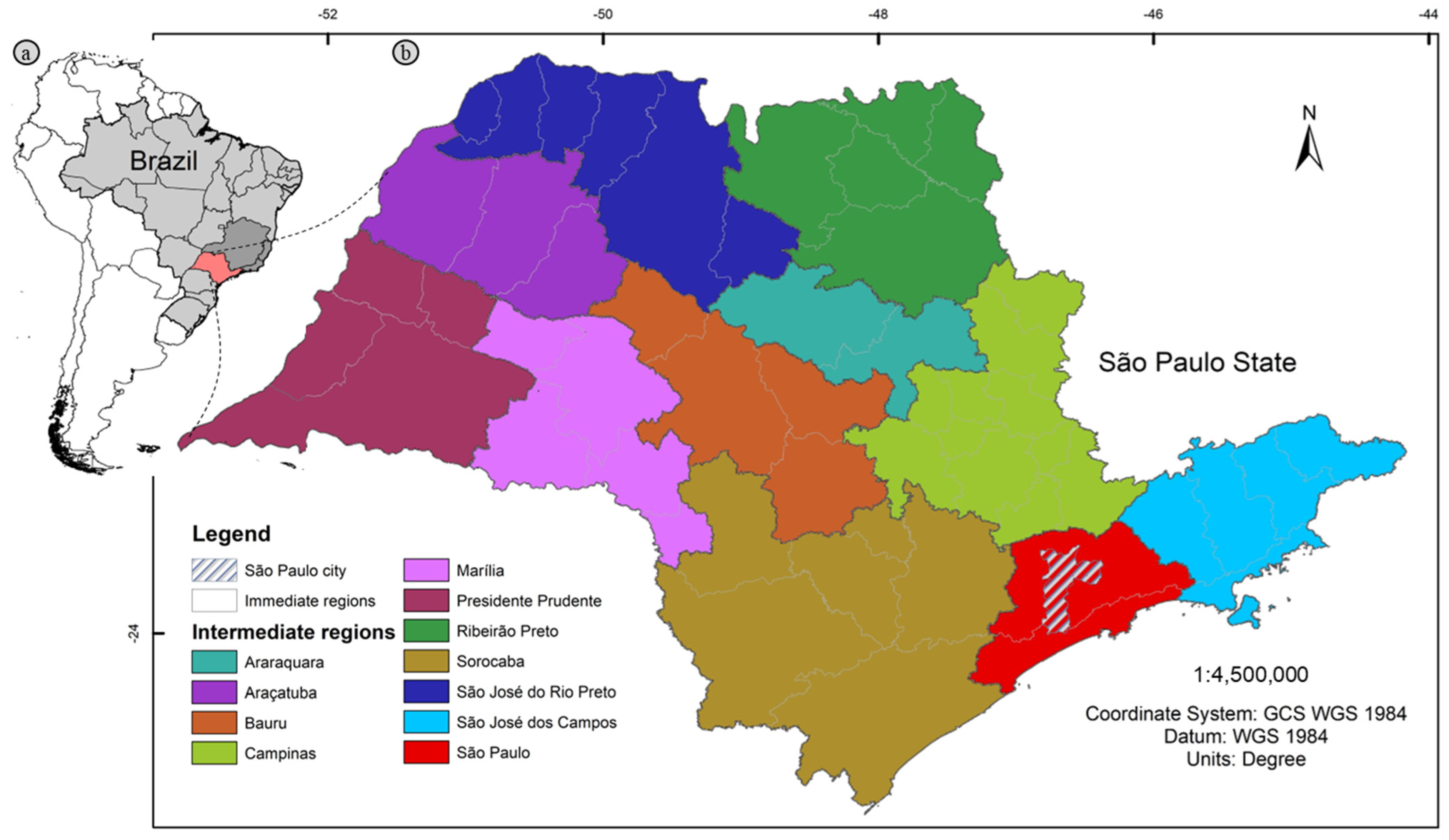

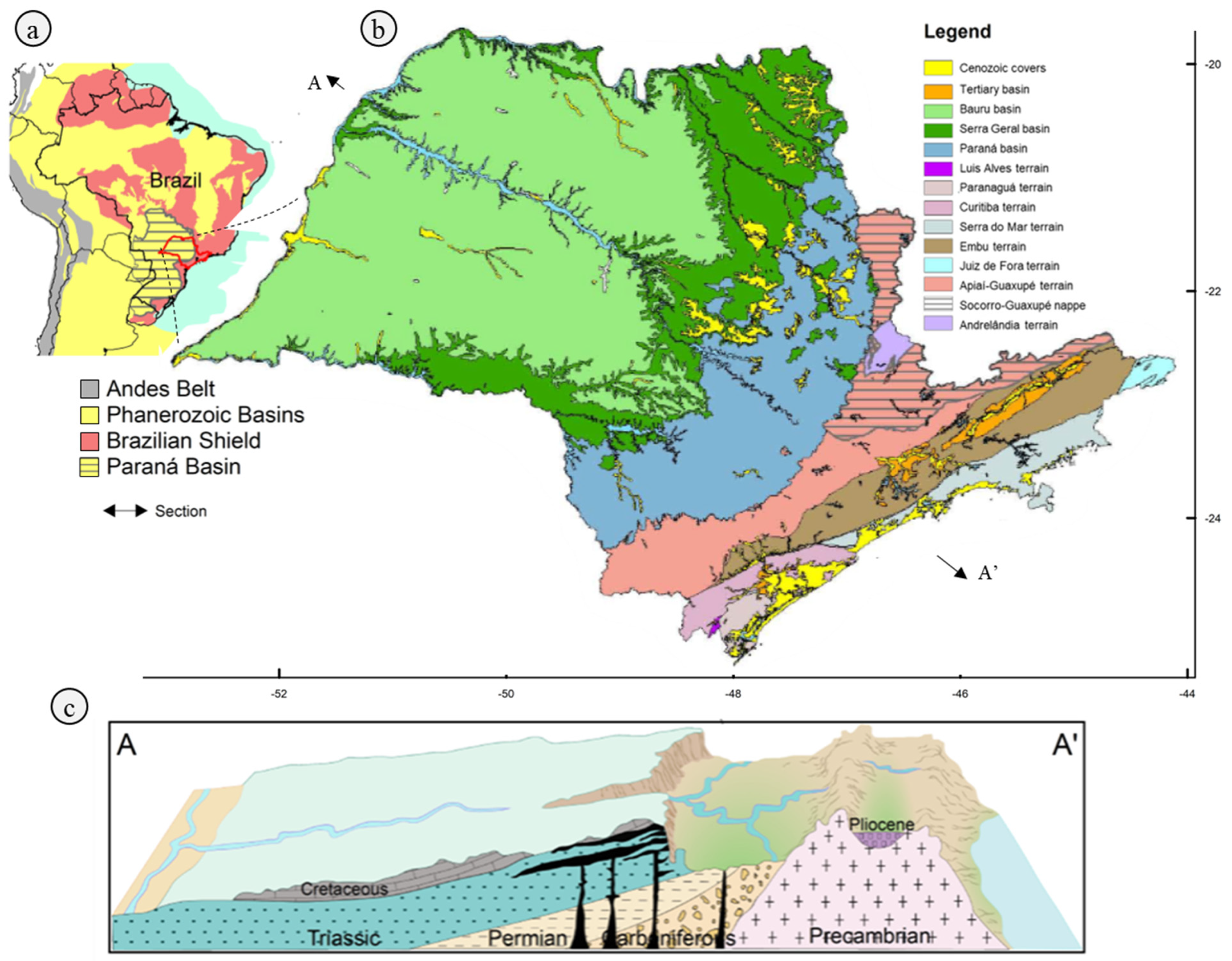
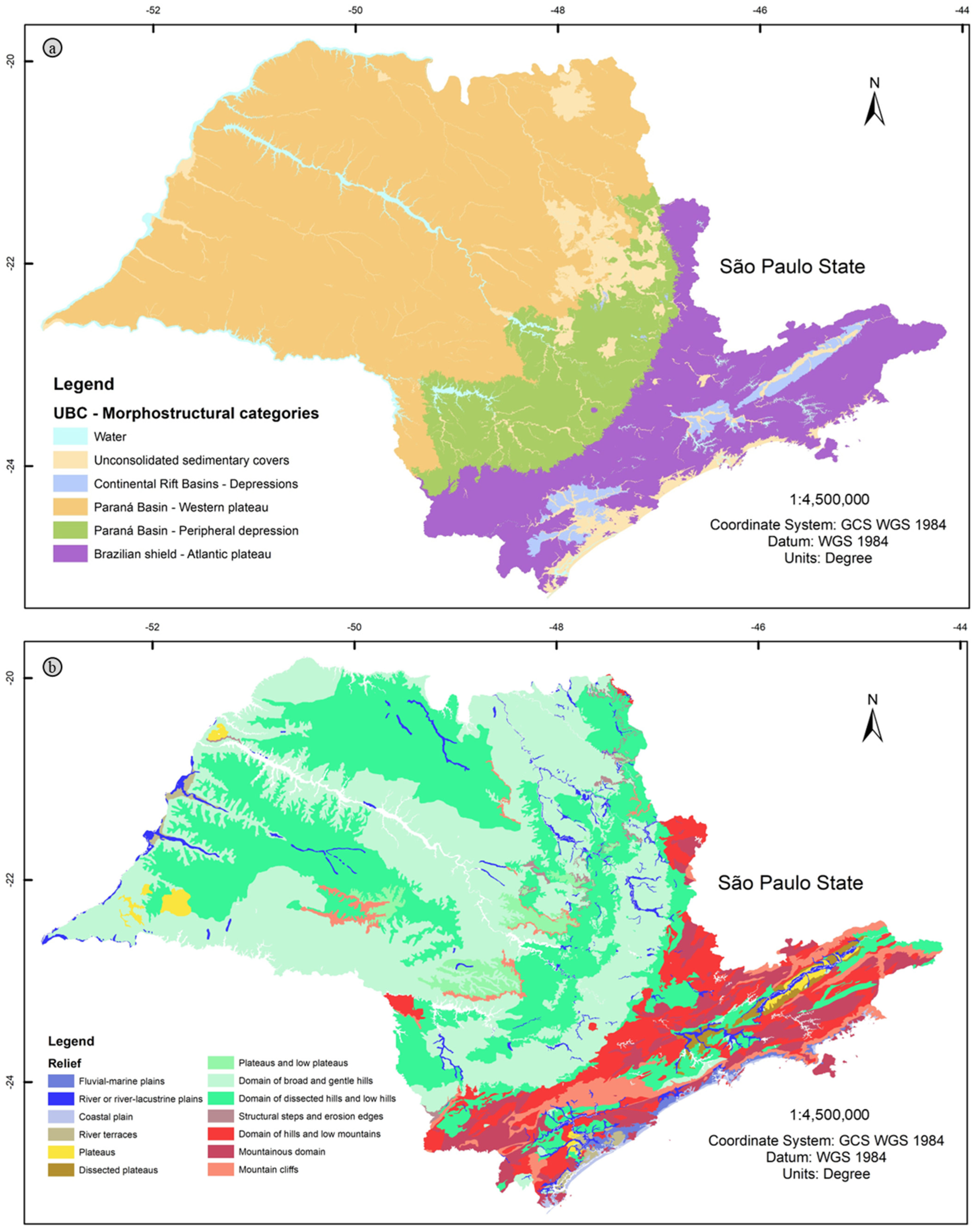

References
- Smith, R.A. The Development of Equipment to Reduce Risk in Rock Climbing. Sports Eng. 1998, 1, 27–39. [Google Scholar] [CrossRef]
- Long, J.; Gaines, B. Climbing Anchors; Rowman & Littlefield: Lanham, MD, USA, 2013; ISBN 978-1-4930-0133-0. [Google Scholar]
- Bollati, I.; Zucali, M.; Giovenco, C.; Pelfini, M. Geoheritage and Sport Climbing Activities: Using the Montestrutto Cliff (Austroalpine Domain, Western Alps) as an Example of Scientific and Educational Representativeness. Ital. J. Geosci. 2014, 133, 187–199. [Google Scholar] [CrossRef]
- Knight, J.; Bollati, I.M. Rock Climbing Sites as Locations for Geoheritage and Geoscience Engagement in Mountains. Geol. Today 2024, 40, 223–227. [Google Scholar] [CrossRef]
- Panizza, M. Geomorphosites: Concepts, Methods and Examples of Geomorphological Survey. Chin. Sci. Bull. 2001, 46, 4–5. [Google Scholar] [CrossRef]
- Panizza, V.; Mennella, M. Assessing Geomorphosites Used for Rock Climbing: The Example of Monteleone Rocca Doria (Sardinia, Italy). Geogr. Helv. 2007, 62, 181–191. [Google Scholar] [CrossRef]
- Bollati, I.; Coratza, P.; Giardino, M.; Laureti, L.; Leonelli, G.; Panizza, M.; Panizza, V.; Pelfini, M.; Piacente, S.; Pica, A.; et al. Directions in Geoheritage Studies: Suggestions from the Italian Geomorphological Community. In Proceedings of the Engineering Geology for Society and Territory—Volume 8; Lollino, G., Giordan, D., Marunteanu, C., Christaras, B., Yoshinori, I., Margottini, C., Eds.; Springer International Publishing: Cham, Switzerland, 2015; pp. 213–217. [Google Scholar]
- Biancotti, A.; Motta, L.; Motta, M. Valutazione della potenzialità d’uso turistico-sportivo di beni paesaggistici: Un esempio d’applicazione ai siti d’arrampicata sportiva. In Proceedings of the II Colloquio Int. “Turismo, Ambiente e Parchi Naturali”, Sharm-el-Sheikh, Egypt, 2–9 June 2001. [Google Scholar]
- Bollati, I.; Fossati, M.; Zanoletti, E.; Zucali, M.; Magagna, A.; Pelfini, M. A Methodological Proposal for the Assessment of Cliffs Equipped for Climbing as a Component of Geoheritage and Tools for Earth Science Education: The Case of the Verbano-Cusio-Ossola (Western Italian Alps). J. Virtual Explor. 2016, 49, 23. [Google Scholar]
- Bollati, I.; Coratza, P.; Panizza, V.; Pelfini, M. Lithological and Structural Control on Italian Mountain Geoheritage: Opportunities for Tourism, Outdoor and Educational Activities. Quaest. Geogr. 2018, 37, 53–73. [Google Scholar] [CrossRef]
- Ruban, D.A.; Ermolaev, V.A. Unique Geology and Climbing: A Literature Review. Geosciences 2020, 10, 259. [Google Scholar] [CrossRef]
- Bollati, I.M.; Masseroli, A.; Al Kindi, M.; Cezar, L.; Chrobak-Žuffová, A.; Dongre, A.; Fassoulas, C.; Fazio, E.; Garcia-Rodríguez, M.; Knight, J.; et al. The IGCP 714 Project “3GEO—Geoclimbing & Geotrekking in Geoparks”—Selection of Geodiversity Sites Equipped for Climbing for Combining Outdoor and Multimedia Activities. Geoheritage 2024, 16, 79. [Google Scholar] [CrossRef]
- CAI Vicenza—Lumignano Classica Regulation. Available online: https://www.caivicenza.it/index.php/ginnastica-e-palestre/admin/69-lumignano-classica-regolamento (accessed on 1 April 2025).
- LIFE 3.0—LIFE Project Public Page. Available online: https://webgate.ec.europa.eu/life/publicWebsite/project/LIFE08-NAT-IT-000362/conservation-actions-habitat-and-species-improvement-and-preservation-of-sic-colli-berici-nature-reserve (accessed on 8 April 2025).
- Haegeli, P.; Pröbstl-Haider, U. Research on Personal Risk in Outdoor Recreation and Nature-Based Tourism. J. Outdoor Recreat. Tour. 2016, 13, 1–9. [Google Scholar] [CrossRef]
- Mata, C.; Pereira, C.; Carvalhinho, L. Safety Measures and Risk Analysis for Outdoor Recreation Technicians and Practitioners: A Systematic Review. Sustainability 2022, 14, 3332. [Google Scholar] [CrossRef]
- Stock, G.M.; Luco, N.; Collins, B.D.; Harp, E.L.; Reichenbach, P.; Frankel, K.L. Quantitative Rock-Fall Hazard and Risk Assessment for Yosemite Valley, Yosemite National Park, California; U.S. Geological Survey: Reston, VA, USA, 2014. [Google Scholar]
- Joffrey Hyman, A.J. Soft Sandstone Rock Anchor Testing at Swinburne. Available online: https://www.climbing.co.za/bolting-information/soft-sandstone-rock-anchor-testing-at-swinburne/ (accessed on 8 March 2025).
- Law, M.; Hawkshaw, S. Testing of Rock Climbing Anchors in Weak Sandstone. Sports Eng. 2015, 18, 21–28. [Google Scholar] [CrossRef]
- Motta, M.; Panizza, V.; Pecci, M. Geomorphological Hazard Assessment on Natural Rock Wall for Free Climbing Practice. Mem. Descr. Della Carta Geol. D’italia 2009, 87, 109–122. [Google Scholar]
- Viana, C.D.; Garcia, G.P.B.; Grohmann, C.H.; Albuquerque, R.W.; Monticelli, J.P.; Cacciari, P.P.; Futai, M.M. Slope Stability Assessment Based on a Digital Outcrop Model: A Case-Study at Jardim Garcia Quarry. In Proceedings of the 14th ISRM Congress, Foz do Iguaçu, Brazil, 13–18 September 2019. [Google Scholar]
- Beni, T.; Gigli, G.; Lombardi, L.; Carlà, T.; Casagli, N. Route Stability Index (RSI): An Index for the Assessment of Rockfall-Related Hazards in Rock Slopes Equipped for Sport Climbing. Geoheritage 2022, 14, 80. [Google Scholar] [CrossRef]
- García-Cortés, A.; Carcavilla, L.; Díaz-Martínez, E.; Vegas, J. Documento Metodológico Para La Elaboración Del Inventario Español de Lugares de Interés Geológico (IELIG); Instituto Geológico y Minero de España (IGME): Madrid, Spain, 2009. [Google Scholar]
- Santos, P.L.A.; Brilha, J. A Review on Tourism Carrying Capacity Assessment and a Proposal for Its Application on Geological Sites. Geoheritage 2023, 15, 47. [Google Scholar] [CrossRef]
- Brilha, J. Inventory and Quantitative Assessment of Geosites and Geodiversity Sites: A Review. Geoheritage 2016, 8, 119–134. [Google Scholar] [CrossRef]
- Guzzetti, F. Landslide Hazard and Risk Assessment. Ph.D. Thesis, Universitäts- und Landesbibliothek Bonn, Bonn, Germany, 2006. [Google Scholar]
- Divisão Regional | IBGE. Available online: https://www.ibge.gov.br/geociencias/organizacao-do-territorio/divisao-regional.html (accessed on 9 March 2025).
- Conti, J.B.; Furlan, S.A. Geoecologia: O Clima, Os Solos e a Biota. In Geografia do Brasil; Edusp: São Paulo, Brazil, 1996. [Google Scholar]
- Souza, C.M.; Shimbo, J.Z.; Rosa, M.R.; Parente, L.L.; Alencar, A.A.; Rudorff, B.F.T.; Hasenack, H.; Matsumoto, M.G.; Ferreira, L.; Souza-Filho, P.W.M.; et al. Reconstructing Three Decades of Land Use and Land Cover Changes in Brazilian Biomes with Landsat Archive and Earth Engine. Remote Sens. 2020, 12, 2735. [Google Scholar] [CrossRef]
- DataGEO—Sistema Ambiental Paulista. Available online: http://datageo.ambiente.sp.gov.br/ (accessed on 9 March 2025).
- Alvares, C.A.; Stape, J.L.; Sentelhas, P.C.; De Moraes Gonçalves, J.L.; Sparovek, G. Köppen’s Climate Classification Map for Brazil. Meteorol. Z. 2013, 22, 711–728. [Google Scholar] [CrossRef]
- Novais, G.T.; Galvani, E. Uma tipologia de classificação climática aplicada ao estado de São Paulo. Rev. Dep. Geogr. 2022, 42, e184630. [Google Scholar] [CrossRef]
- Heilbron, M.; Valeriano, C.M.; Tassinari, C.C.G.; Almeida, J.; Tupinambá, M.; Siga, O., Jr.; Trouw, R. Correlation of Neoproterozoic Terranes between the Ribeira Belt, SE Brazil and Its African Counterpart: Comparative Tectonic Evolution and Open Questions. In West Gondwana: Pre-Cenozoic Correlations Across the South Atlantic Region; Pankhurst, R.J., Trouw, R.A.J., Neves, B.B.d.B., de Wit, M.J., Eds.; The Geological Society of London: London, UK, 2008; Volume 294, ISBN 978-1-86239-247-2. [Google Scholar]
- de Brito Neves, B.B.; Fuck, R.A. Neoproterozoic Evolution of the Basement of the South-American Platform. J. S. Am. Earth Sci. 2013, 47, 72–89. [Google Scholar] [CrossRef]
- Campanha, G.A.D.C.; Sadowski, G.R. Tectonics of the Southern Portion of the Ribeira Belt (Apiaí Domain). Precambrian Res. 1999, 98, 31–51. [Google Scholar] [CrossRef]
- Janasi, V.D.A.; Alves, A.; Vlach, S.R.F.; Leite, R.J. Granitos peraluminosos da porção central da Faixa Ribeira, Estado de São Paulo: Sucessivos eventos de reciclagem da crosta continental no neoproterozóico. Geol. USP Sér. cient. 2003, 3, 13–24. [Google Scholar] [CrossRef]
- Meira, V.T. Evolução Tectono-Metamórfica Neoproterozoica dos Complexos Embu e Costeiro no Contexto de Formação do Gondwana Ocidental (Leste do Estado de São Paulo). Ph.D. Thesis, Universidade de São Paulo: São Paulo, Brazil, 2015. [Google Scholar]
- Garcia, M.d.G.M.; Brilha, J.; de Lima, F.F.; Vargas, J.C.; Pérez-Aguilar, A.; Alves, A.; Campanha, G.A.d.C.; Duleba, W.; Faleiros, F.M.; Fernandes, L.A.; et al. The Inventory of Geological Heritage of the State of São Paulo, Brazil: Methodological Basis, Results and Perspectives. Geoheritage 2018, 10, 239–258. [Google Scholar] [CrossRef]
- Riccomini, C.; Peloggia, A.U.G.; Saloni, J.C.L.; Kohnke, M.W.; Figueira, R.M. Neotectonic Activity in the Serra Do Mar Rift System (Southeastern Brazil). J. S. Am. Earth Sci. 1989, 2, 191–197. [Google Scholar] [CrossRef]
- Hasui, Y. Neotectonics and Fundamental Aspects of Resurgent Tectonics in Brazil. In Proceedings of the Neotectonics and Cenozoic Continental Sedimentation in Southeastern Brazil Workshop, São Paulo, Brazil, 1990; pp. 1–31. [Google Scholar]
- Perrotta, M.M.; Salvador, E.D.; Lopes, R.D.C.; D’Agostino, L.Z.; Peruffo, N.; Gomes, S.D.; Sachs, L.L.B.; Meira, V.T.; Garcia, M.D.G.M.; Lacerda Filho, J.V. Mapa Geológico Do Estado de São Paulo, Escala 1: 750.000; Programa Geologia do Brasil–PGB, CPRM: São Paulo, Brazil, 2005. [Google Scholar]
- Ross, J.L.S. Geografia Do Brasil; EDUSP: São Paulo, Brazil, 2005; Volume 3. [Google Scholar]
- Mantesso-Neto, V.; Ribeiro, R.R.; Garcia, M.G.M.; Del Lama, E.A.; Theodorovicz, A. Patrimônio geológico no estado de São Paulo. Bol. Parana. Geociências 2013, 70, 53–76. [Google Scholar] [CrossRef][Green Version]
- CBME—Confederação Brasileira de Montanhismo e Escalada. Available online: https://cbme.org.br/novo/ (accessed on 9 March 2025).
- Escaladas.com.br. Available online: https://www.escaladas.com.br/ (accessed on 9 March 2025).
- Homepage | Copernicus. Available online: https://www.copernicus.eu/en (accessed on 9 March 2025).
- Secretaria de Turismo e Viagens. ROTAS TURÍSTICAS. Available online: https://www.turismo.sp.gov.br:443/acoes-e-programas-rotas-turisticas (accessed on 9 April 2025).
- Dowling, R.; Newsome, D. Handbook of Geotourism; Edward Elgar Publishing: Cheltenham, UK, 2018. [Google Scholar]
- Hose, T.A. 3G’s for Modern Geotourism. Geoheritage 2012, 4, 7–24. [Google Scholar] [CrossRef]
- Reynard, E.; Buckingham, T.; Martin, S.; Regolini, G. Geoheritage, Geoconservation and Geotourism in Switzerland. In Landscapes and Landforms of Switzerland; Reynard, E., Ed.; Springer International Publishing: Cham, Switzerland, 2021; pp. 411–425. ISBN 978-3-030-43203-4. [Google Scholar]
- Secretaria de Turismo e Viagens do Estado de São Paulo. Available online: https://www.turismo.sp.gov.br/municipiosturisticos (accessed on 9 April 2025).
- Machado, R.M.; Hanashiro, W.S.; Barreto, O.F.G.; de Almeida, V.A.A. Políticas Públicas De Apoio Ao Desenvolvimento Dos Municípios Turísticos Do Estado De São Paulo. Rev. Jurídica OAB Tatuapé 2023, 2. [Google Scholar]
- Gordon, J.E.; Crofts, R.; Díaz-Martínez, E.; Woo, K.S. Enhancing the Role of Geoconservation in Protected Area Management and Nature Conservation. Geoheritage 2018, 10, 191–203. [Google Scholar] [CrossRef]
- Stewart, I.S.; Gill, J.C. Social Geology—Integrating Sustainability Concepts into Earth Sciences. Proc. Geol. Assoc. 2017, 128, 165–172. [Google Scholar] [CrossRef]
- “Colocou Pessoas Sob Risco de Morte”, Diz Bombeiro Sobre Coach Que Organizou Trilha No Pico Dos Marins | Vale Do Paraíba e Região | G1. Available online: https://g1.globo.com/sp/vale-do-paraiba-regiao/noticia/2022/01/07/colocou-pessoas-sob-risco-de-morte-diz-bombeiro-sobre-coach-que-organizou-trilha-no-pico-dos-marins.ghtml (accessed on 9 March 2025).
- Correio Braziliense Pedra se Solta e Mata Estudante Durante Escalada. Available online: https://www.correiobraziliense.com.br/brasil/2021/11/4960302-pedra-se-solta-e-mata-estudante-durante-escalada.html (accessed on 9 March 2025).
- UIAA 123:2020; Rock Anchors: Climbing and Mountaineering Equipment. UIAA: Bern, Switzerland, 2020.
- Marques, E.A.G.; Barroso, E.V.; Menezes Filho, A.P.; Vargas, E.d.A. Weathering Zones on Metamorphic Rocks from Rio de Janeiro—Physical, Mineralogical and Geomechanical Characterization. Eng. Geol. 2010, 111, 1–18. [Google Scholar] [CrossRef]
- Monticelli, J.P.; Ribeiro, R.; Futai, M. Relationship between Durability Index and Uniaxial Compressive Strength of a Gneissic Rock at Different Weathering Grades. Bull. Eng. Geol. Environ. 2020, 79, 1381–1397. [Google Scholar] [CrossRef]
- Fell, R.; Ho, K.K.S.; Leroi, S.L.; Leroi, E. A Framework for Landslide Risk Assessment and Management. In Landslide Risk Management; CRC Press: Florida, FL, USA, 2005; ISBN 978-0-429-15135-4. [Google Scholar]
- Política Nacional de Proteção e Defesa Civil—PNPDEC. Available online: https://www.planalto.gov.br/ccivil_03/_ato2011-2014/2012/lei/l12608.htm (accessed on 9 April 2025).
- Peppoloni, S.; Capua, G.D. Geoethics: Manifesto for an Ethics of Responsibility Towards the Earth; Springer Nature: Berlin, Germany, 2022; ISBN 978-3-030-98044-3. [Google Scholar]
- Peppoloni, S.; Capua, G.D. Geoethics: The Role and Responsibility of Geoscientists; Geological Society of London: London, UK, 2015; ISBN 978-1-86239-726-2. [Google Scholar]
- Secretaria de Turismo e Viagens. Plano Turismo SP 2030. Available online: https://www.turismo.sp.gov.br/plano20-30 (accessed on 9 April 2025).
- Gordon, J.E. Geoheritage, Geotourism and the Cultural Landscape: Enhancing the Visitor Experience and Promoting Geoconservation. Geosciences 2018, 8, 136. [Google Scholar] [CrossRef]
- Henriques, M.H.; dos Reis, R.P.; Brilha, J.; Mota, T. Geoconservation as an Emerging Geoscience. Geoheritage 2011, 3, 117–128. [Google Scholar] [CrossRef]
- Reynard, E.; Brilha, J. Geoheritage: Assessment, Protection, and Management; Elsevier: Philadelphia, PA, USA, 2017; ISBN 978-0-12-809542-3. [Google Scholar]
- Crofts, R.; Gordon, J.E.; Brilha, J.B.; Gray, M.; Gunn, J.; Larwood, J.; Santucci, V.L.; Tormey, D.; Worboys, G.L. Guidelines for Geoconservation in Protected and Conserved Areas; International Union for Conservation of Nature (IUCN): Gland, Switzerland, 2020; ISBN 978-2-8317-2079-1. [Google Scholar]
- Brilha, J.; Monge-Ganuzas, M.; Woo, K.S.; Casadevall, T.; Migoń, P.; Gunn, J.; Erikstad, L.; Page, K.; Da, M.; Garcia, G.; et al. Key Geoheritage Areas Scoping Study and Guidelines; WCPA: Gland, Switzerland, 2025. [Google Scholar] [CrossRef]
- Gray, M.; Gordon, J.E.; Brown, E.J. Geodiversity and the Ecosystem Approach: The Contribution of Geoscience in Delivering Integrated Environmental Management. Proc. Geol. Assoc. 2013, 124, 659–673. [Google Scholar] [CrossRef]

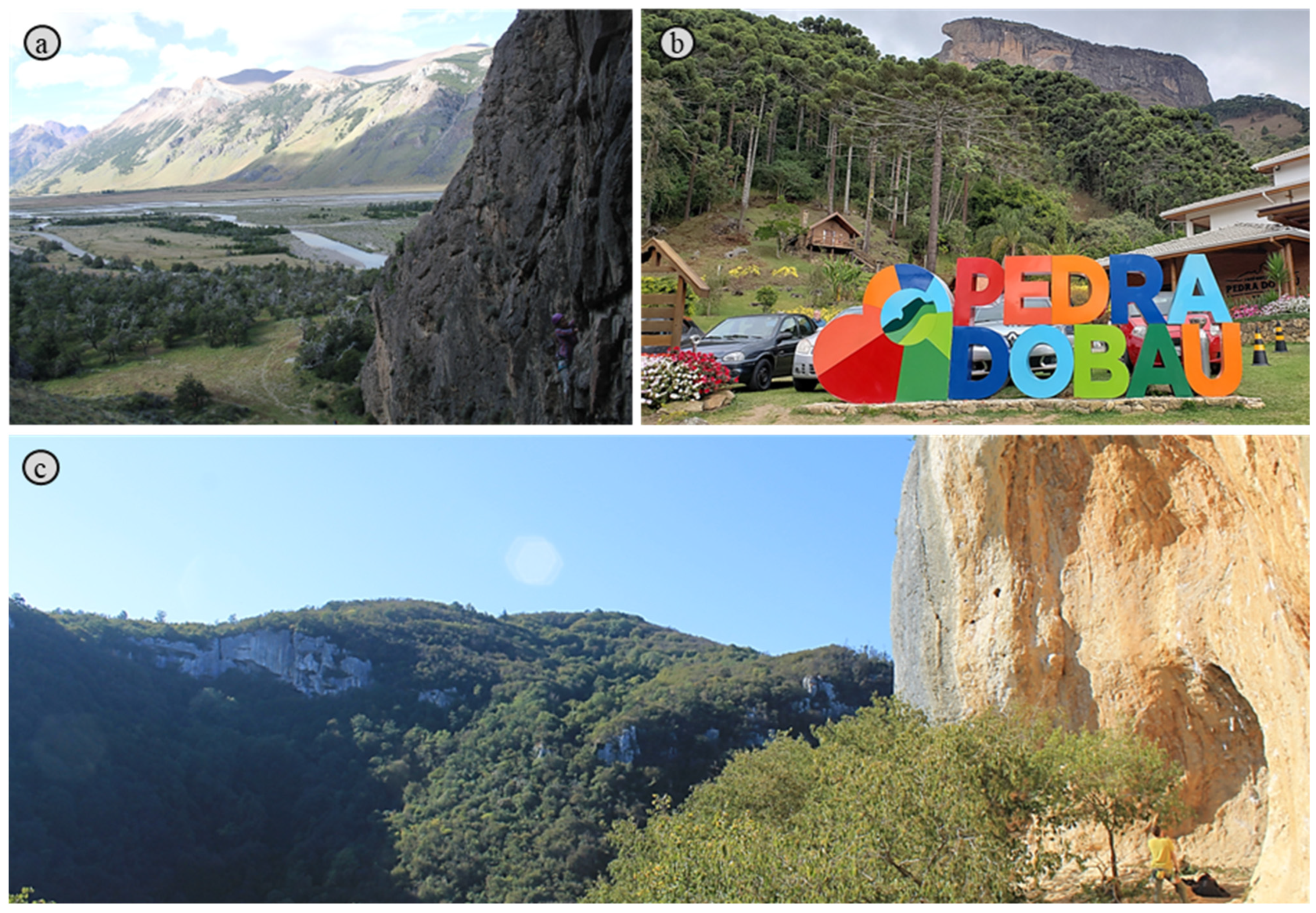
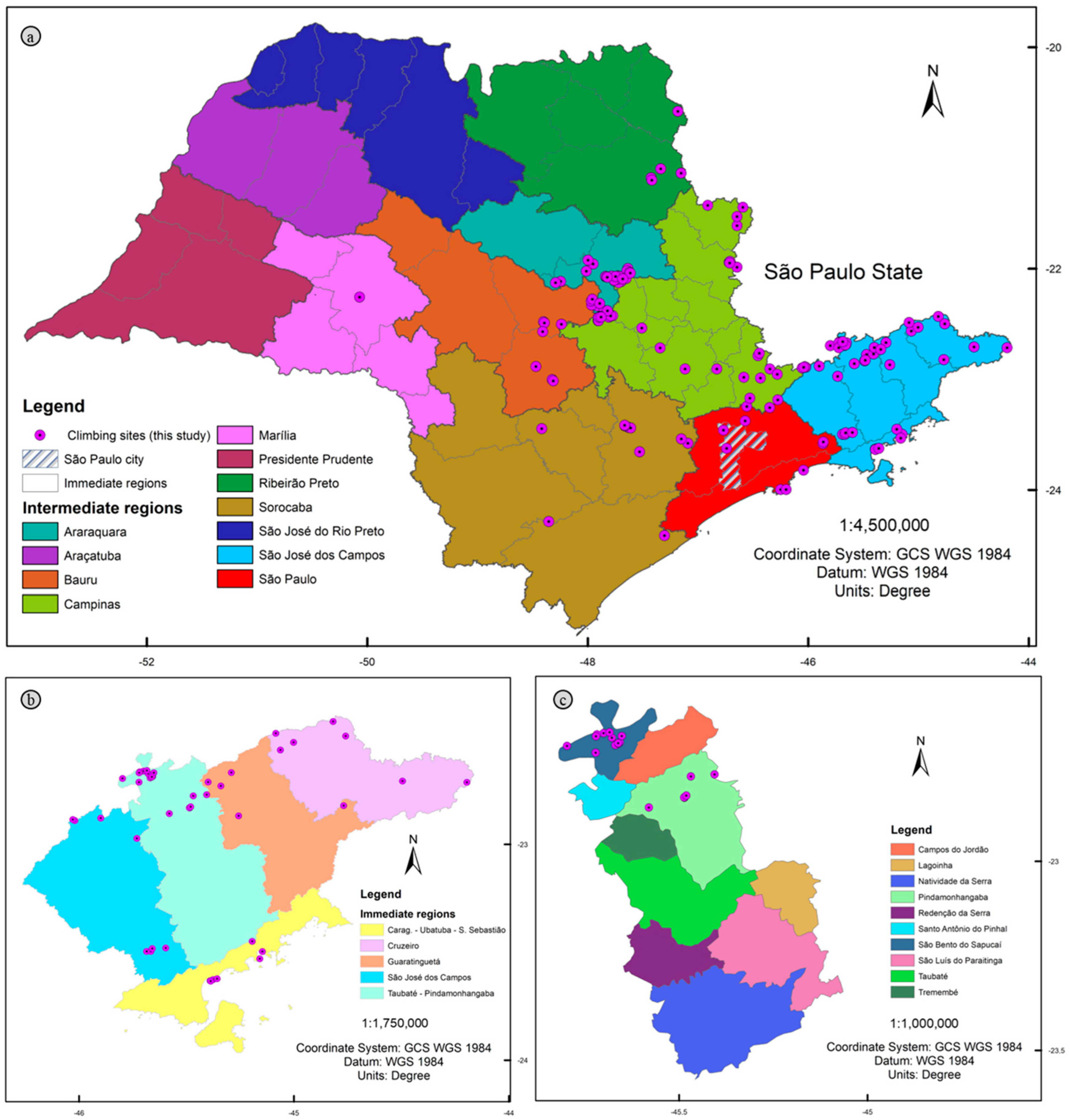
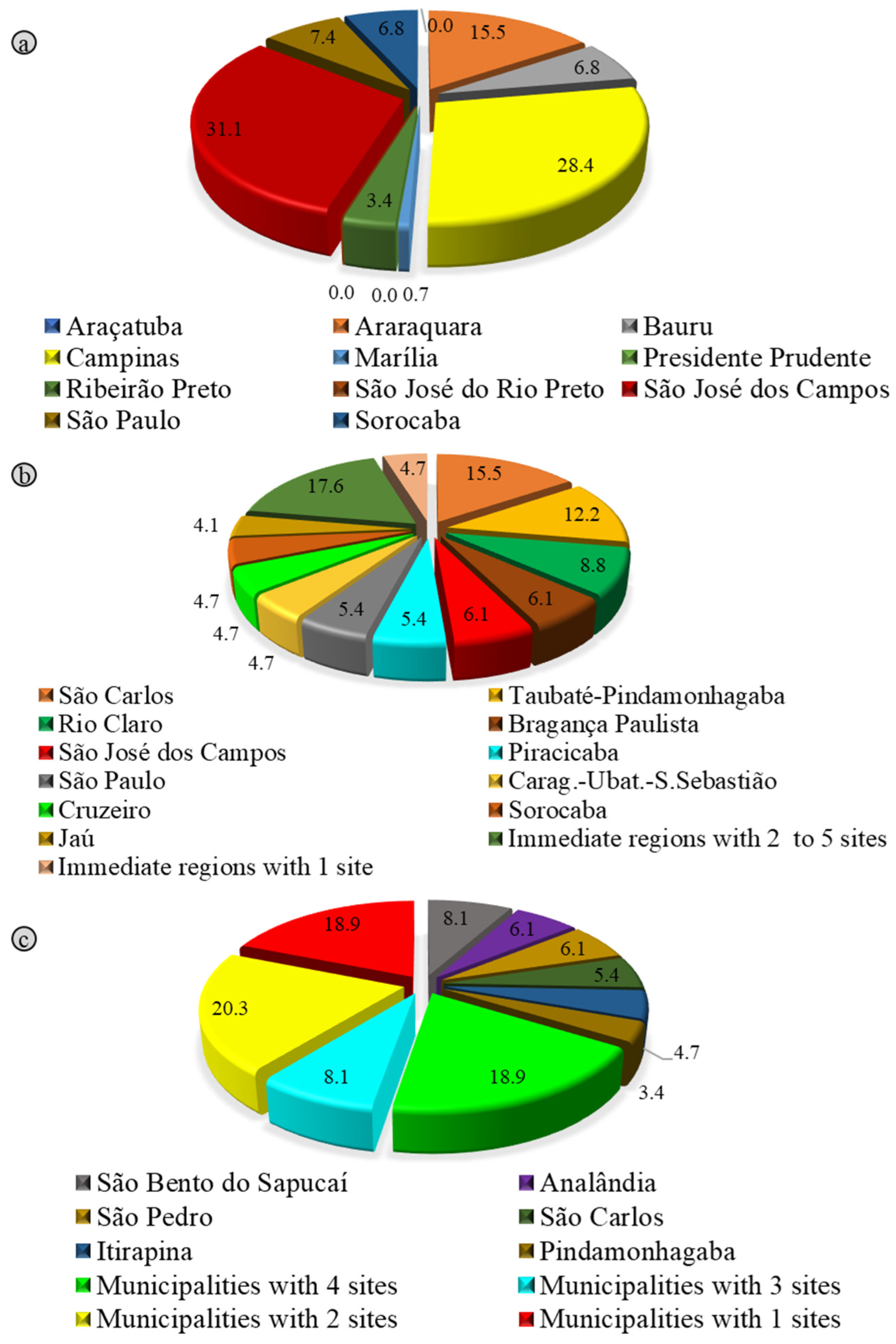

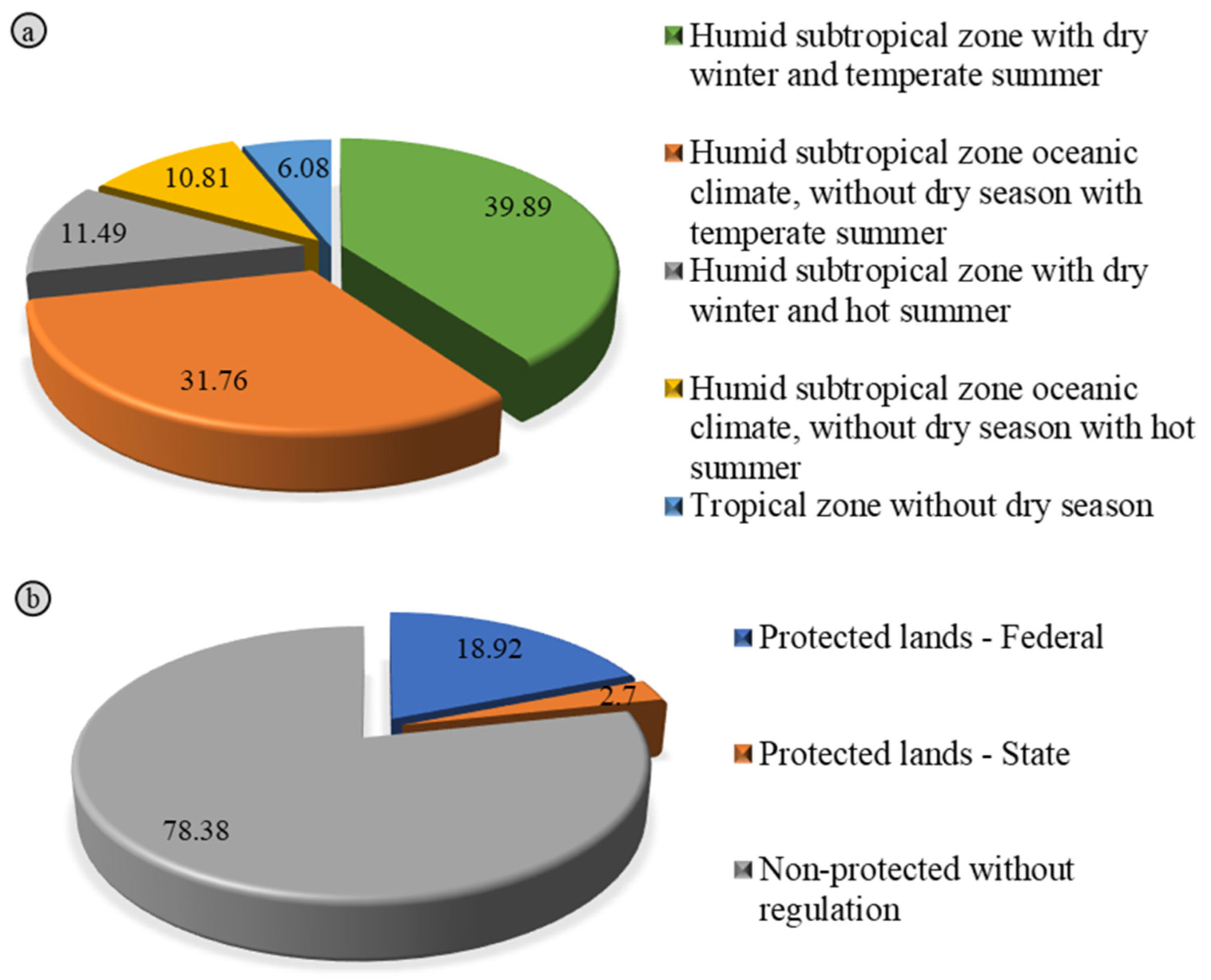
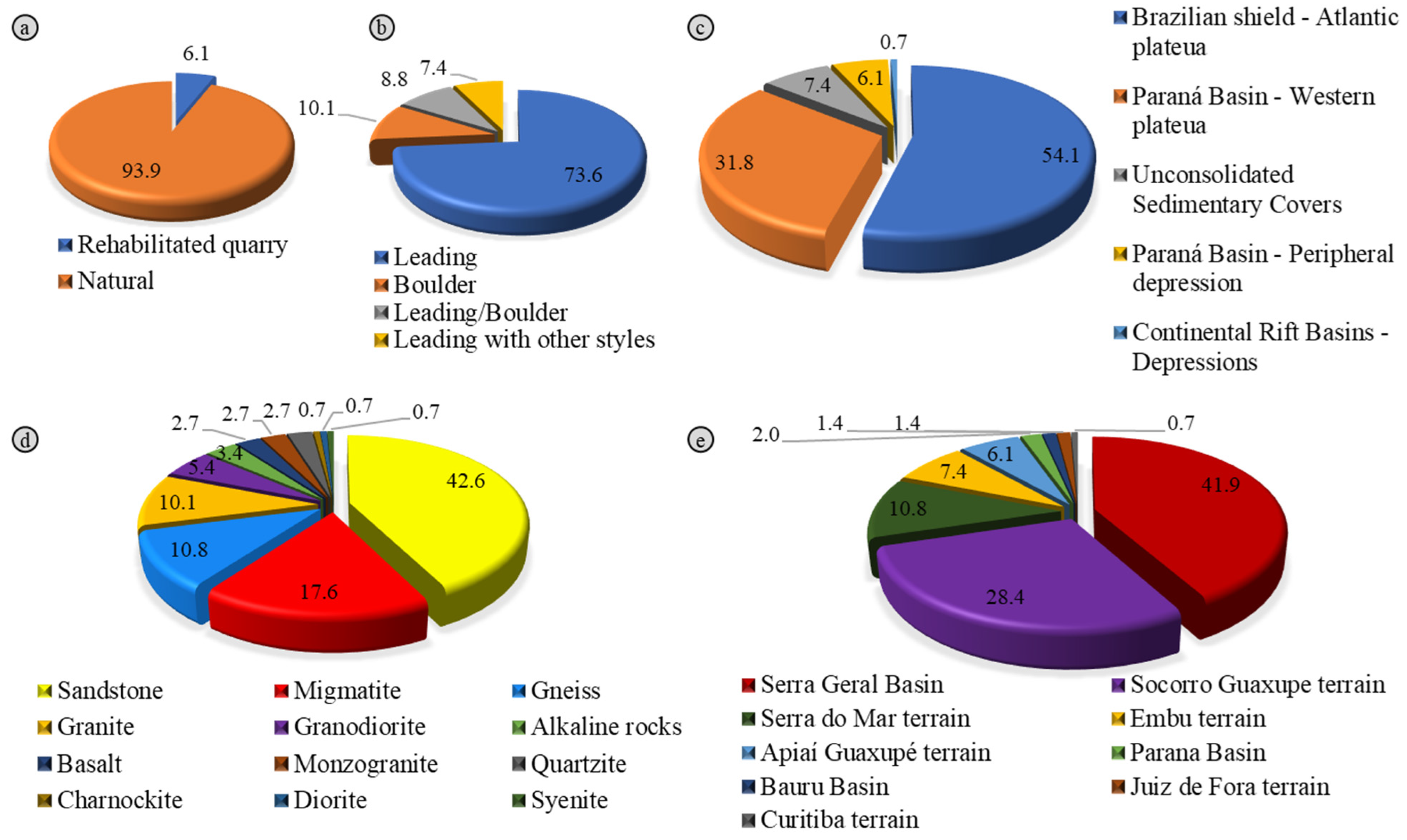
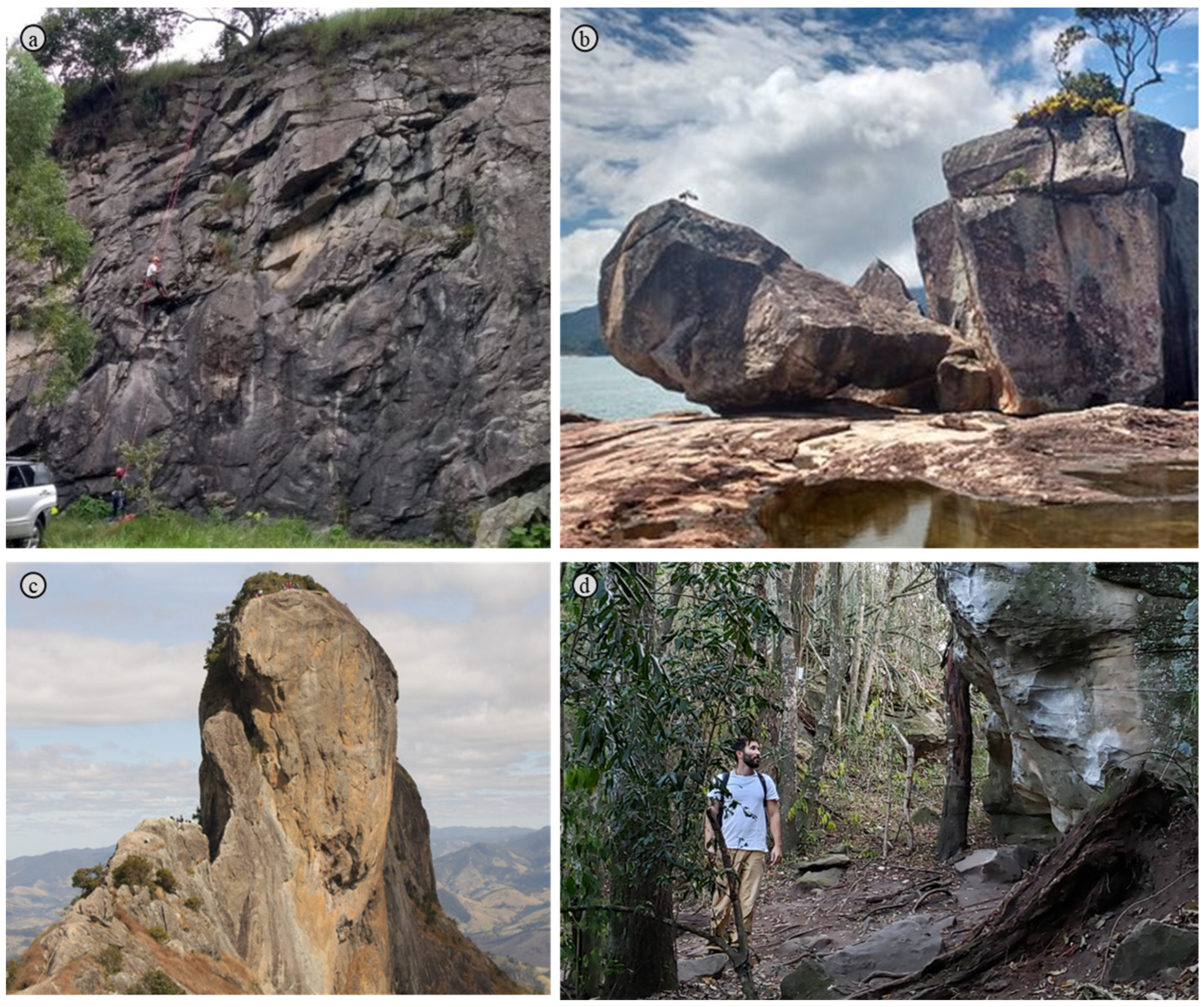
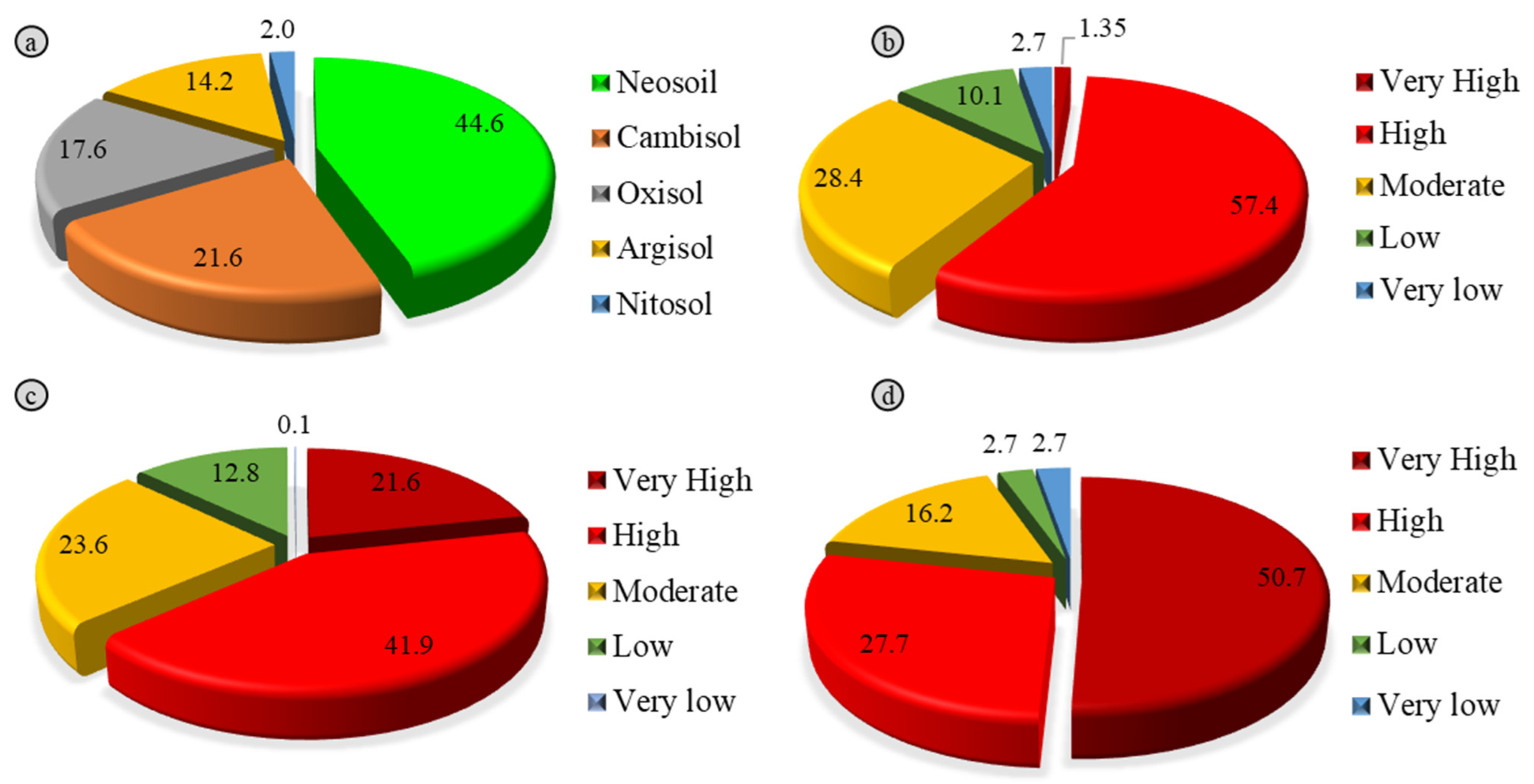

Disclaimer/Publisher’s Note: The statements, opinions and data contained in all publications are solely those of the individual author(s) and contributor(s) and not of MDPI and/or the editor(s). MDPI and/or the editor(s) disclaim responsibility for any injury to people or property resulting from any ideas, methods, instructions or products referred to in the content. |
© 2025 by the authors. Licensee MDPI, Basel, Switzerland. This article is an open access article distributed under the terms and conditions of the Creative Commons Attribution (CC BY) license (https://creativecommons.org/licenses/by/4.0/).
Share and Cite
Monticelli, J.P.; Garcia, M.d.G.M.; Frugis, G.L.; Ribeiro, R.P. Inventory of Climbing Sites in São Paulo State, Brazil: Integrating Geodiversity Data for Sustainable Adventure Tourism. Sustainability 2025, 17, 3900. https://doi.org/10.3390/su17093900
Monticelli JP, Garcia MdGM, Frugis GL, Ribeiro RP. Inventory of Climbing Sites in São Paulo State, Brazil: Integrating Geodiversity Data for Sustainable Adventure Tourism. Sustainability. 2025; 17(9):3900. https://doi.org/10.3390/su17093900
Chicago/Turabian StyleMonticelli, João Paulo, Maria da Glória Motta Garcia, Gabriella Labate Frugis, and Rogério Pinto Ribeiro. 2025. "Inventory of Climbing Sites in São Paulo State, Brazil: Integrating Geodiversity Data for Sustainable Adventure Tourism" Sustainability 17, no. 9: 3900. https://doi.org/10.3390/su17093900
APA StyleMonticelli, J. P., Garcia, M. d. G. M., Frugis, G. L., & Ribeiro, R. P. (2025). Inventory of Climbing Sites in São Paulo State, Brazil: Integrating Geodiversity Data for Sustainable Adventure Tourism. Sustainability, 17(9), 3900. https://doi.org/10.3390/su17093900







